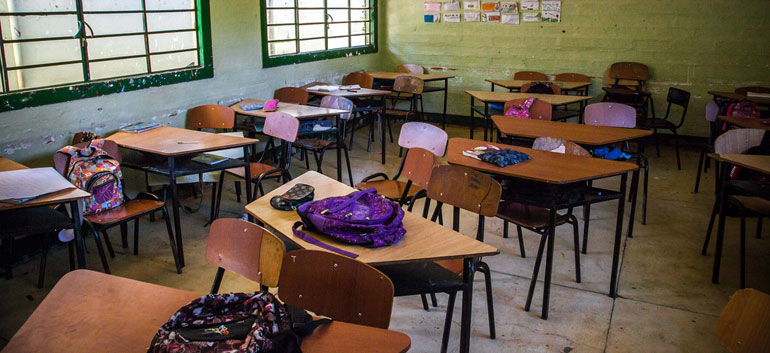Colombia’s largest criminal networks are increasingly extorting the Andean nation’s teachers, national media reported Sunday.
Teachers, who make among the lowest salaries of any established professionals in Colombia, have reported receiving threats from people claiming affiliations with “Los Urabeños” or “Los Rastrojos,” two of the largest criminal organizations in the country responsible for a significant percentage of its drug trade. Gang members are said to demand between $1,000 and $3,000, threatening the teachers with direct knowledge of their place of work, homes and families.
MORE: 600 Colombian teachers threatened in past 12 months
According to an one investigator, such extortion has been made possible because “teachers are easily intimidated, partly because they have been victims for years and because they are not used to dealing with criminals,” reported Semana magazine.
The nature of their work has traditionally brought teachers into conflict with various armed groups, including both rebel and paramilitary organizations, who have targeted teachers who have spoken out against gang culture or resisted child recruitment efforts.
MORE: Colombia’s teachers threaten to join national strike
Following previous rounds of negotiation with the national teachers union (FECODE) last year, the government agreed to provide teachers with additional security measures. Last fall, the government only just avoided a protracted shutdown of its public education system, when teachers threatened strike, in part because these safety measures have not been implemented properly, or managed to stem a wave of targeted violence directed at teachers throughout the country.
In 2010, for example, professor Duvian Rojo reported the extortion of 20 teachers in the central state of Antioquia, including himself. Days later, Rojo and his wife were murdered, leaving their three children orphaned. Although the attackers were never caught, the event inspired others to band together for safety and report their own experiences of extortion. Between 2011 and 2012 , over 100 statements were given in Antioquia alone, according to the magazine.
In 2013, in the northern state of Cordoba, 189 teachers from three municipalities gave similar statements. Reports from Caldas, Cundinamarca and Tolima spoke of a man named “Carlos,” who claimed to be a member of the Urabeños and told them he would kill them if they did not give him between $1,000 and $3,000.
The gang members reportedly gained such private information about the educators by telephoning their places of work and posing as representatives of humanitarian agencies. Information was requested and given under the pretense of the teachers being recruited to work for the organizations but was actually used as leverage in the extortion cases.
MORE: Colombia’s Ombudsman asks to protect more than 1000 threatened teachers
Investigators in Medellin, Colombia’s second largest city, traced the money trail and charged five women who made up a gang called “las Gatas” on February 29. The women claimed to be working on orders from an inmate at the Picaleña Jail in Ibague, central-western Colombia, alias “JJ,” who had a database of information about teachers across the country and would make the threatening phone calls from his prison cell.
Similarly, an inmate in a prison in the state Santander, alias, “Ronald,” reportedly called victims while posing as the leader of the Urabeños, and between 2012 and 2013 managed to extort $120,000 from teachers across the country, collected by two women working for him on the outside. Both women were arrested for extortion in June 2013.
Such threats hold weight with educators as they have long suffered at the hands of criminal organisations. Angel Garcia, Education Secretary of Nariño, south-western Colomia, told El Tiempo newspaper that, in 2013, it received 88 reports of teachers being threatened by armed groups, in some cases forcing teachers to leave schools where they had worked for over 20 years.
Despite protestations made by the Ministry of National Education that “in each state there should be a Special Committee created to study, evaluate and resolve cases of threat to life and personal integrity brought against faculty and staff of educational institutions,” teachers continue to suffer.
As for why the gangs target teachers, a group that tends to receive low annual salaries, General Guatibonza, director of the Anti-Extortion and Anti-Kidnapping Group (GAULA), told Semana magazine, “The extortionists often study the behavior of the guilds. And the so-called ‘helping-culture’ in certain sectors.”
By this, Guatibonza is referring to the judicious savings culture within the teachers guild. Across Colombia, there are roughly 300,000 members in 32 unions through which teachers have created cooperatives for savings and easy loan options, meaning that despite low initial wages, many teachers have high amounts of savings and easy access to cash.
The Colombian Federation of Educators (FECODE) was not available for comment at this time.
Sources
- Docentes, el nuevo objetivo de las ‘Bacrim’ (Semana)
- Las Bacrim amenazan a docentes en Nariño (El Tiempo)
- En 2012, 56 docentes fueron amenazados en Magdalena (El Tiempo)
- Reubicacion docentes amenazados (Ministry of National Education)


